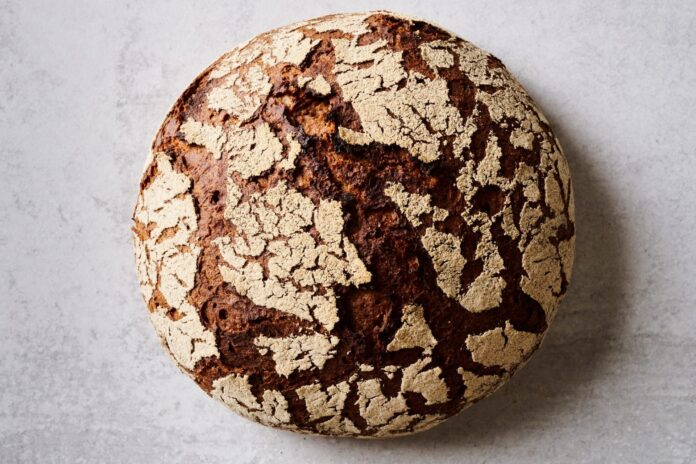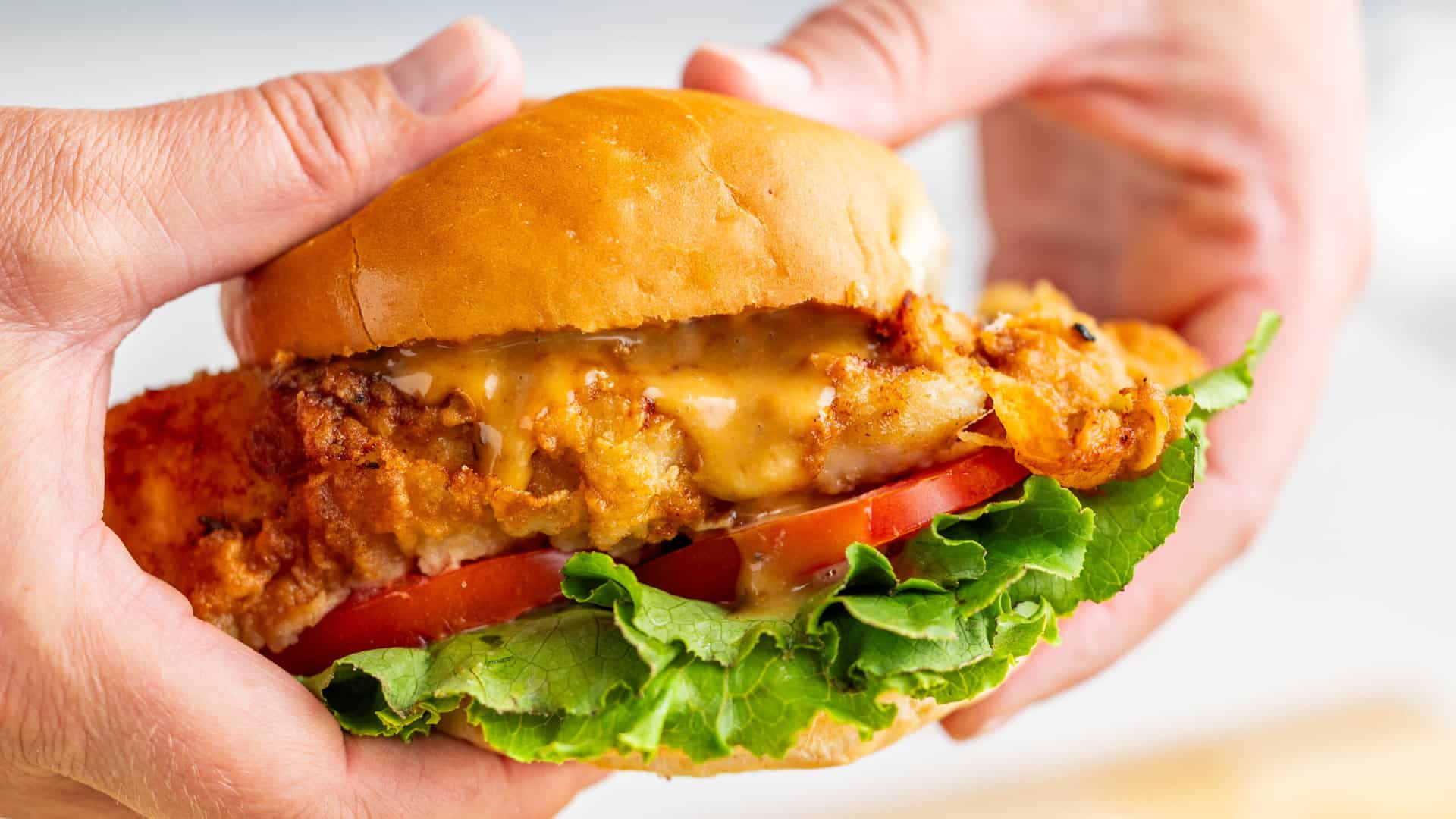Combine complete darkish rye flour and water along with your fingers, and also you’re instantly plunged into an intense sensory expertise. Earthy aromas swirl about as a dough texture that’s not in contrast to moist concrete begins to kind. When the grey paste squishes and squashes by way of your fingers, you start to listen to whispers from someplace in your head: How can this dense, shreddy coalescence make a cohesive, ethereal, and crusty loaf of sourdough rye bread?
This bread steals your consideration—it’s all you’ll take into consideration at breakfast, lunch, and dinner.
The reply, as is the case with lots of the recipes you’ll discover right here, is fermentation. But additionally, whereas all rye flour lacks the identical glutenous traits of wheat flour (particularly high-protein white flour), it has pentosans. Pentosans are polysaccharides that soak up copious quantities of water, which steam within the oven throughout baking, puffing up the dough. In addition they kind a gel community that helps lure the gaseous byproducts of fermentation. Lastly, pentosans assist the starches gelatinize throughout baking, which units the smooth, ethereal construction of rye-based bakes.
However the stars of the present with rye bread (as I’ve come to sincerely recognize over time I’ve baked it at residence,) are its fascinating aroma and sturdy malty taste. This bread steals your consideration—it’s all you’ll take into consideration at breakfast, lunch, and dinner. When you earn a living from home, be ready to listen to its name from the kitchen whenever you least anticipate it. You’ll need it sliced skinny and topped merely with good salted butter. You’ll need it to accompany your smoked salmon. You’ll start to need it with absolutely anything you’ve gotten within the fridge.
Listed below are just a few vital particulars I’ve discovered when making any sourdough rye bread:
- Use a big preferment; a minimum of 40% of the overall flour is fermented forward of time
- When utilizing whole-grain rye flour, enhance the hydration dramatically for the perfect texture
- Make use of a brief bulk fermentation and quick closing proof
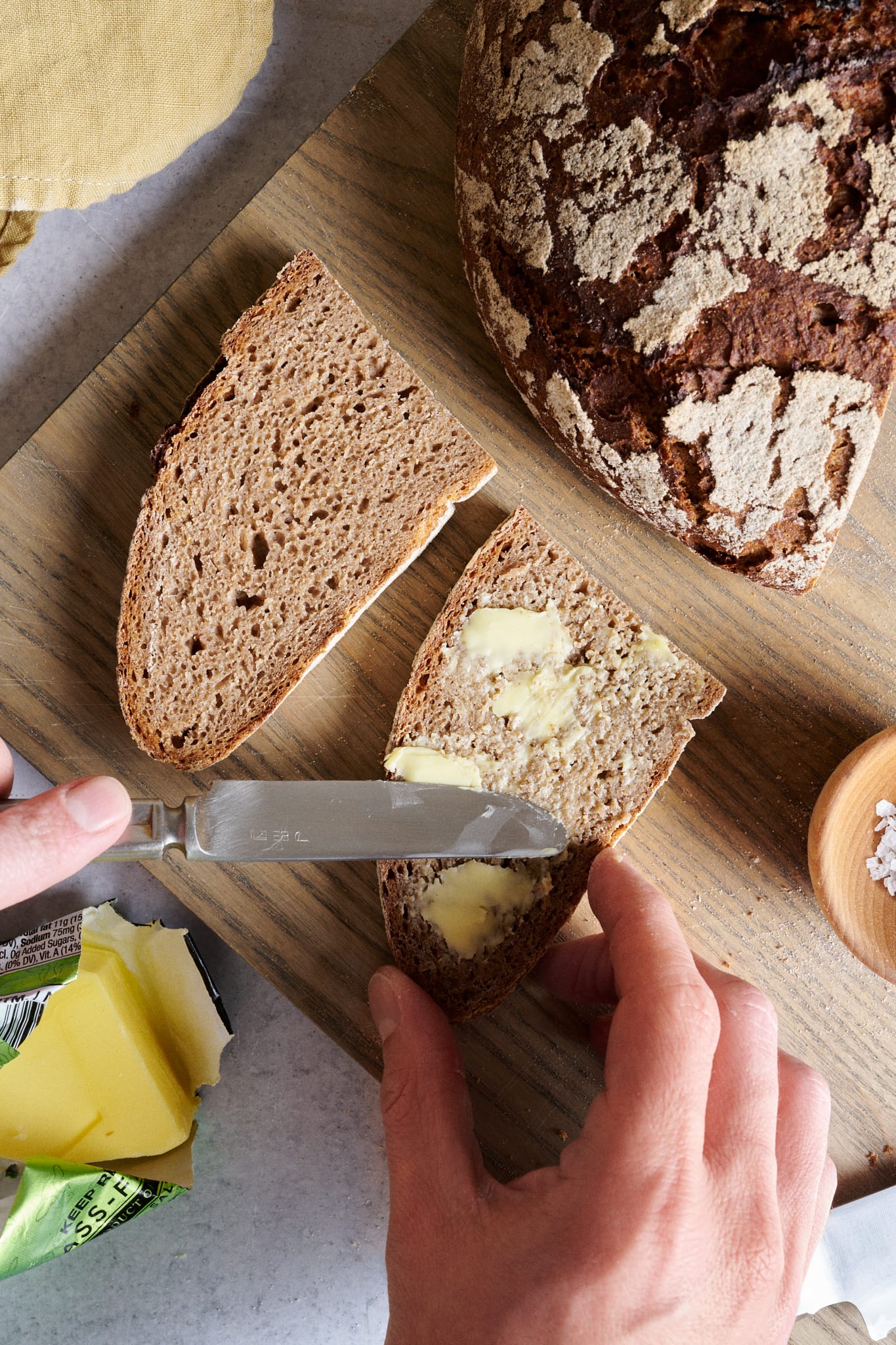

Instagram Walkthrough
Click on play under to look at me make this sourdough rye bread on Instagram.
Why is a Massive Preferment Essential with Rye Bread?
One factor you’ll discover with this sourdough rye bread, and with nearly each sourdough rye bread, is the extremely massive preferment relative to the overall flour within the recipe. When making correct rye, it’s essential to ferment a big proportion of the flour within the recipe beforehand.
Why? The big preferment ensures that when the dough is blended, it has a excessive acidity (low pH) from the beginning. This low pH inhibits extreme amylase enzyme exercise, stopping extreme starch breakdown, particularly throughout baking. If rye doughs will not be correctly acidified with sourdough, this starch breakdown will lead to bread with a gummy inside and a separation between the highest crust and inside of the loaf.
On this recipe, I name for 45% of the overall flour within the levain, and whereas this may increasingly appear to be so much in comparison with different sourdough recipes right here at The Good Loaf, it’s really moderately average in comparison with different rye recipes corresponding to a multi-stage vollkornbrot or 100% whole-grain rye just like the roggenvollkornbrot in my cookbook.
Lastly, the big preferment additionally signifies that a lot of the flour within the recipe has fermented for an extended time period, which provides it time to construct up copious quantities of natural taste compounds. This flavorful combination instantly interprets into the ultimate dough.
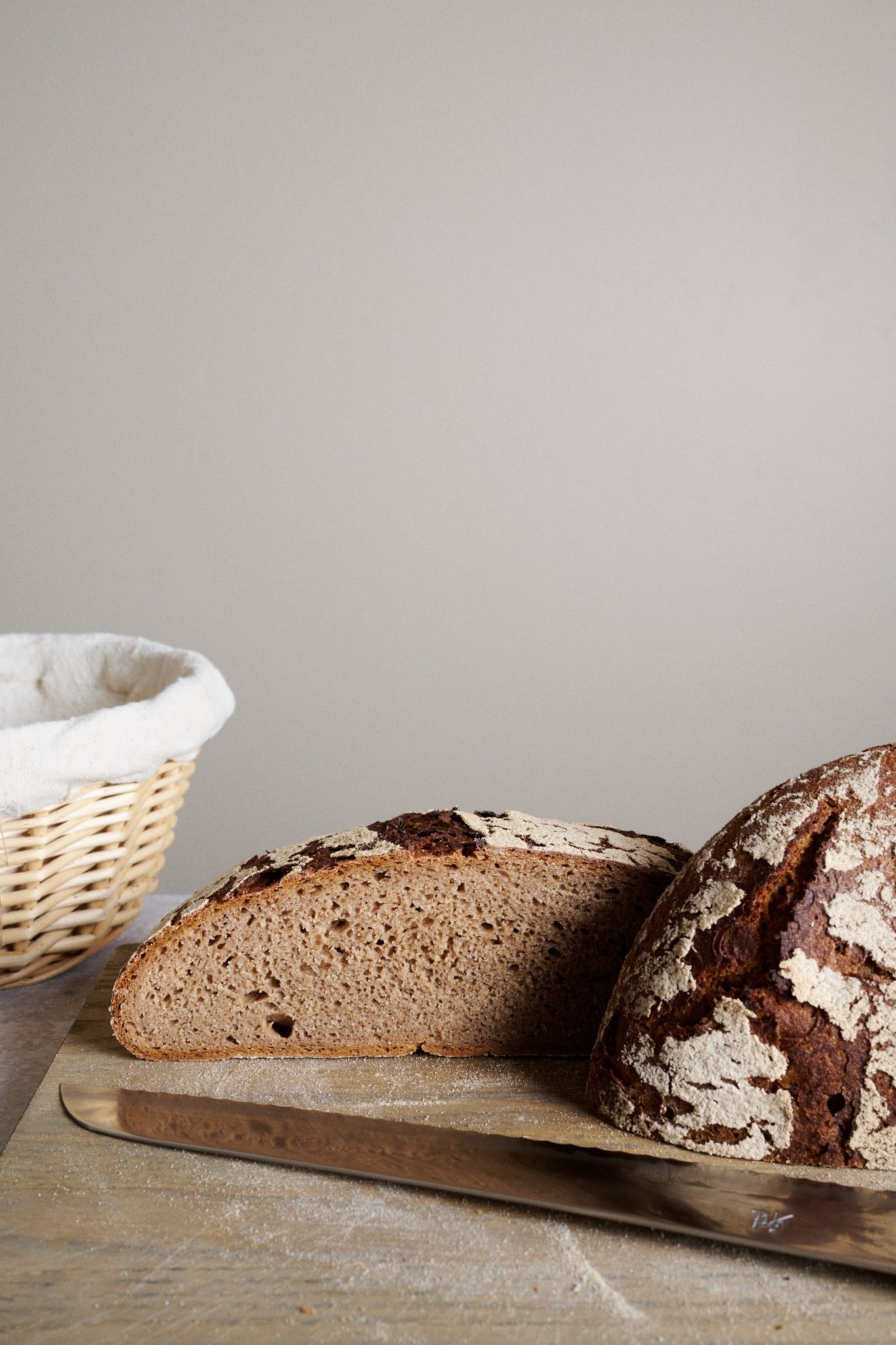

Flour Choice
This sourdough rye bread requires complete darkish rye (the identical flour you would possibly discover in rugbrød, Danish rye bread). This implies the flour isn’t sifted and comprises your complete rye berry. Holding the bran and germ brings elevated taste to the ultimate loaf, particularly, a extra earthy and sturdy taste profile that’s a contact nutty. Moreover, by conserving the bran and germ, the ensuing sourdough rye bread could have extra fiber, be richer in vitamins, and hold you full longer.
Along with the entire rye, I name for 10% high-protein white bread flour to assist lighten the loaf only a bit. This greater protein flour brings a contact of airiness and openness to this rye, making for the right counterbalance to the darkish, heavy rye. When you don’t have any high-protein white flour readily available, be at liberty to make use of medium-protein or all-purpose flour.
For a better take a look at what makes rye so nice (and so scrumptious), see The Whys of Ryes →
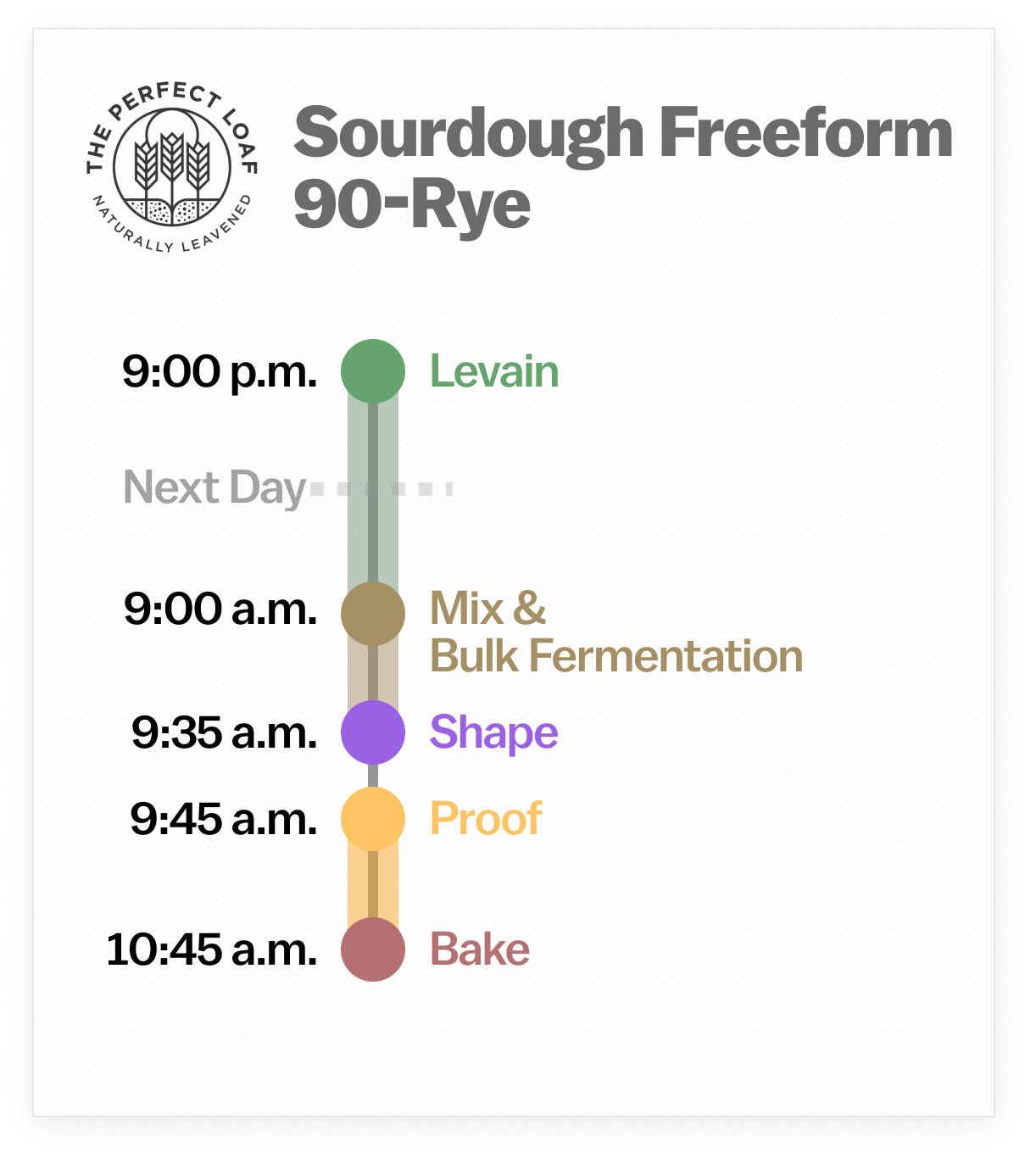

Baking Schedule
The unimaginable factor about making sourdough rye bread with plenty of rye flour and a big preferment is that the schedule is comparatively quick and the loaf is straightforward to make. The preferment (levain) runs in a single day for 12 hours; the following day, after a brief combine, fermentation time, and bake, you’ll have a loaf of rye bread cooling in your countertop.
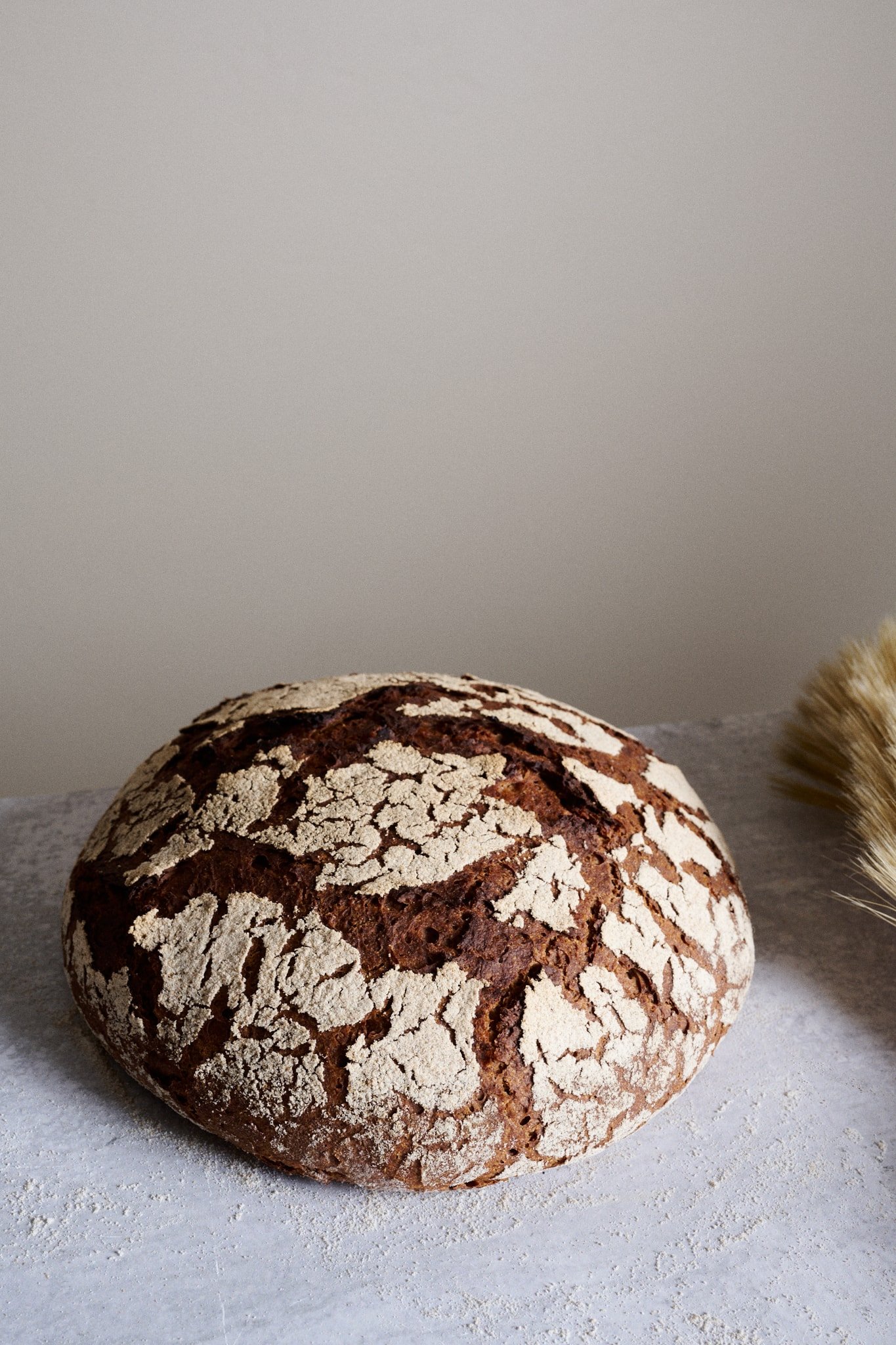

Sourdough 90-Rye Bread Recipe
This 1,200-gram loaf is massive, but it surely’s the right dimension for per week of consuming. If you wish to scale the recipe up, together with doubling the recipe, use baker’s percentages.
Vitals
| Whole dough weight | 1,200 grams |
| Pre-fermented flour | 45.0% |
| Hydration | 90.0% |
| Yield | 1 loaf |
Whole System
This whole components desk exhibits all of the elements you could make this sourdough rye bread. Within the Methodology, under, the elements shall be damaged down into precisely what you want for every step.
Desired dough temperature: 82°F (28°C).
| Weight | Ingredient | Baker’s Share |
|---|---|---|
| 544g | Entire rye flour (Central Milling Natural Entire Darkish Rye) | 90.0% |
| 60g | Excessive-protein white bread flour (~12.7% protein, King Arthur Bread Flour) | 10.0% |
| 544g | Water | 90.0% |
| 11g | Wonderful sea salt | 1.8% |
| 41g | Ripe sourdough starter, 100% hydration | 6.8% |
Sourdough 90-Rye Bread Methodology
1. Put together the levain – 9:00 p.m. (the day earlier than mixing)
| Weight | Ingredient | Baker’s proportion |
| 272g | Entire rye flour | 100.0% |
| 272g | Water 1 (levain) | 100.0% |
| 41g | Ripe sourdough starter, 100% hydration | 15.0% |
Combine the elements within the chart above in a big jar or medium bowl and go away them coated with a lid or reusable plastic bowl cowl at a heat temperature, 74-76°F (23-24°C), to ripen in a single day.
Be aware that it is a very massive levain, so make certain your container can maintain the elements plus a little bit room for growth in a single day. My favourite container for this dimension levain, seed soakers, and different massive preferments, are 1-quart round Cambro Camwear containers.
2. Combine – 9:00 a.m. (the following day)
| Weight | Ingredient |
| 272g | Entire rye flour |
| 60g | Excessive-protein white bread flour |
| 272g | Water |
| 11g | Wonderful sea salt |
| 585g | Ripe levain (from Step 1) |
Within the morning, the levain ought to have risen and aerated considerably (see under). The aroma of the levain will nearly be earthy with fruity overtones, related in a solution to darkish pink wine.
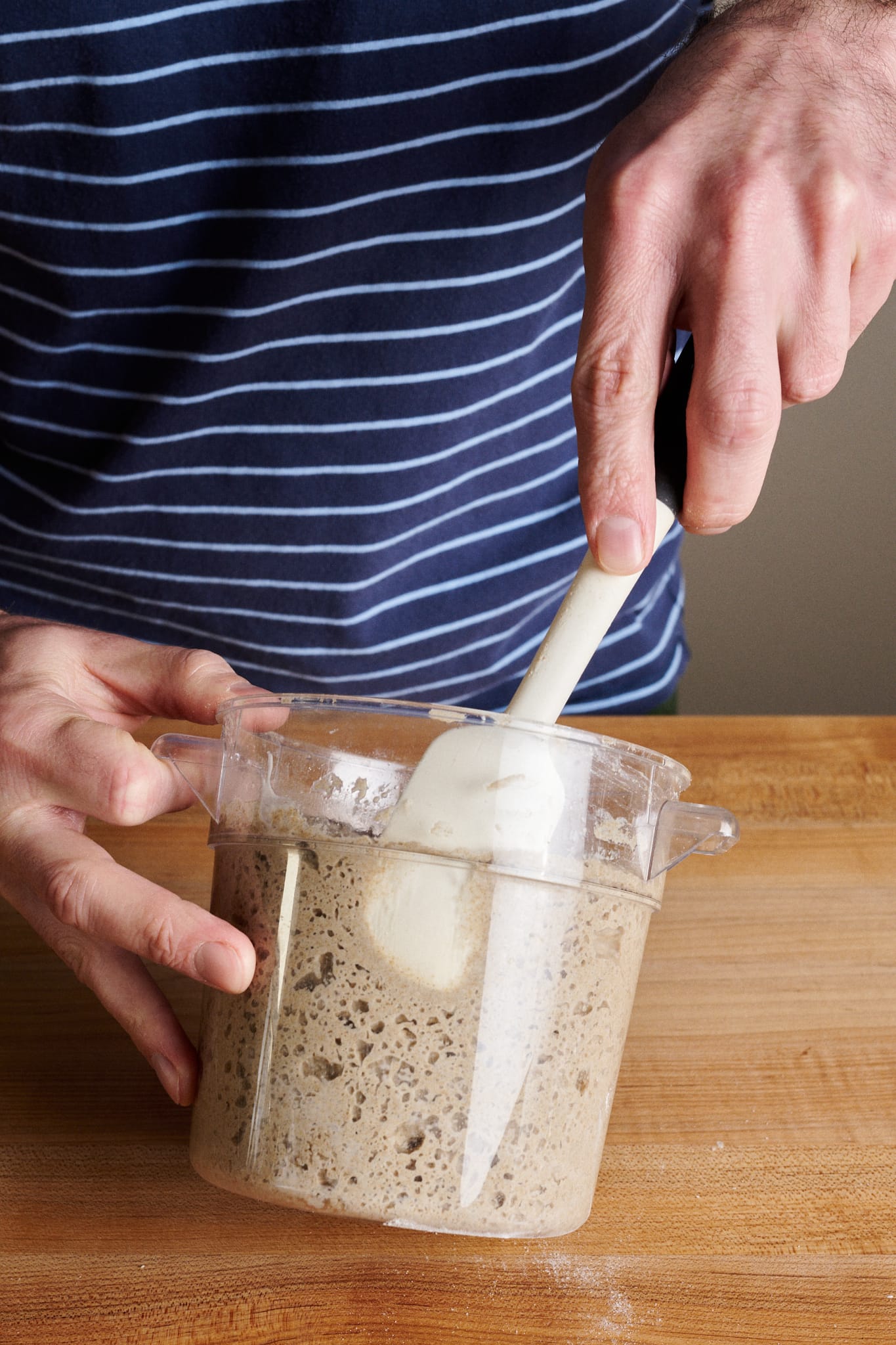

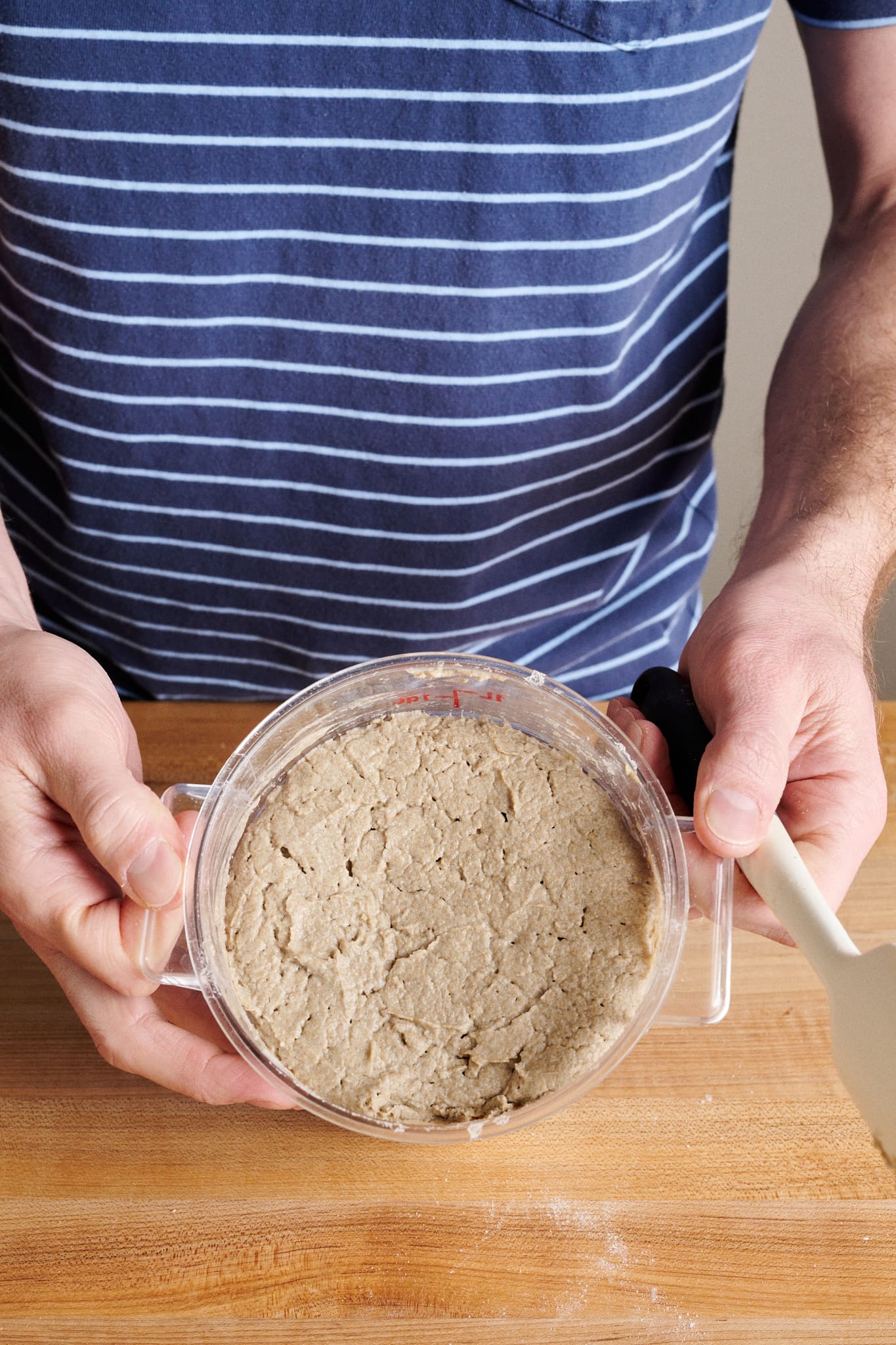

With this rye dough, it’s vital to hit the specified dough temperature (DDT) of 82°F (28°C). That is hotter than typical bulk fermentation temperatures right here at The Good Loaf, so heat the blending water as vital to make sure the dough finally ends up at that temperature (see the information to dough temperatures for a helpful chart and calculator for determining this water temperature).
Hydration Be aware: As with all bread recipe, you would possibly want to regulate the dough’s hydration to fit your flour (particularly if baking in a moist atmosphere. When mixing, maintain again a little bit of the water and add it provided that the dough appears like it will possibly deal with it (take a look at the pictures under to assist choose the consistency).
Place the flour, water (see be aware above), salt, and levain in a big bowl. With moist fingers (or, my choice, utilizing a sturdy dough whisk), combine totally till no dry bits stay (see under, left). Rye doesn’t profit from mixing and kneading in the identical manner as wheat attributable to its low gluten content material. Subsequently, it’s solely vital to combine this dough till no dry flour stays.
Collect up the dough right into a ball within the heart of the blending bowl (see under, proper). Take the dough’s temperature to document the ultimate dough temperature, after which cowl.
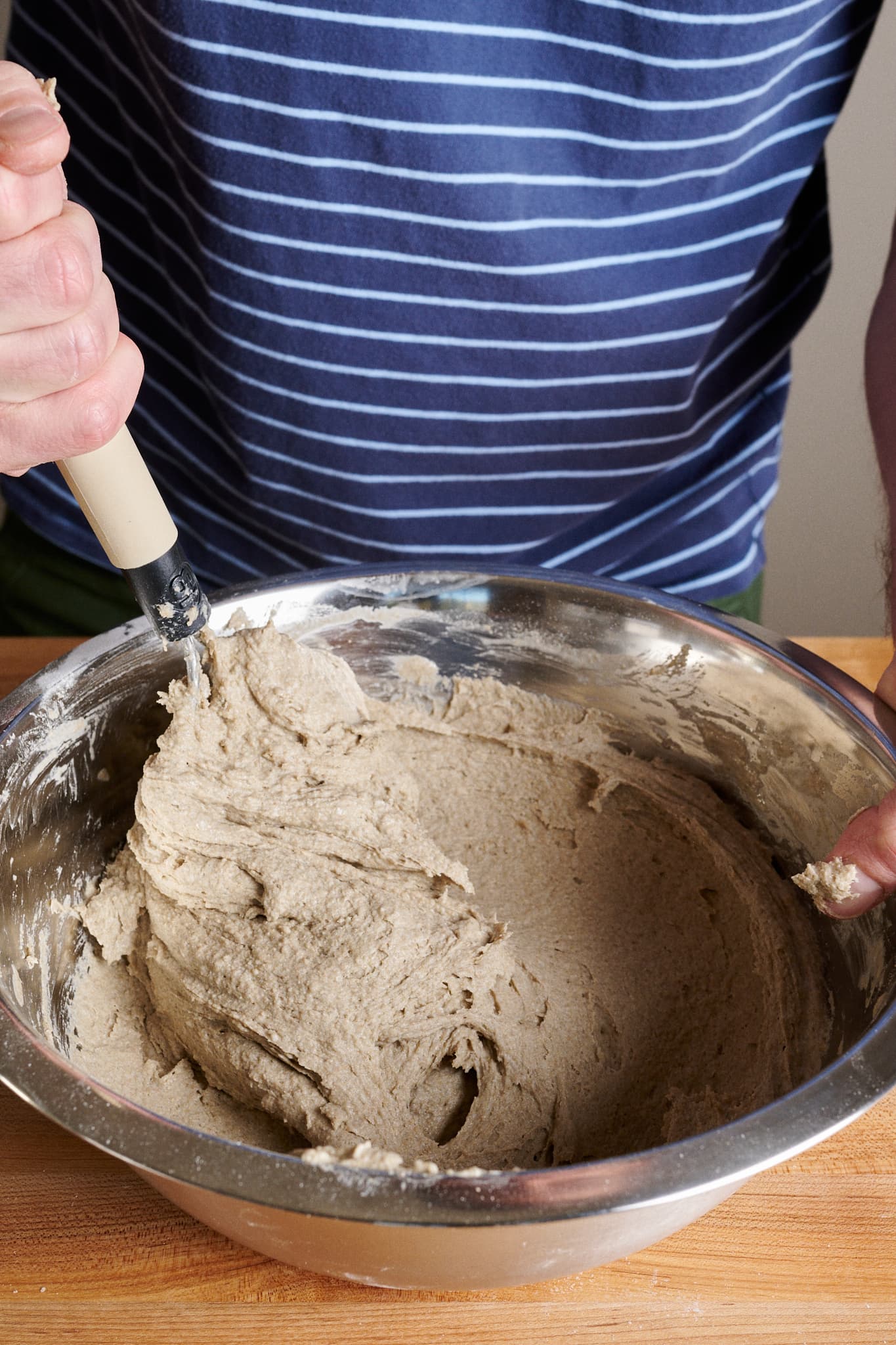

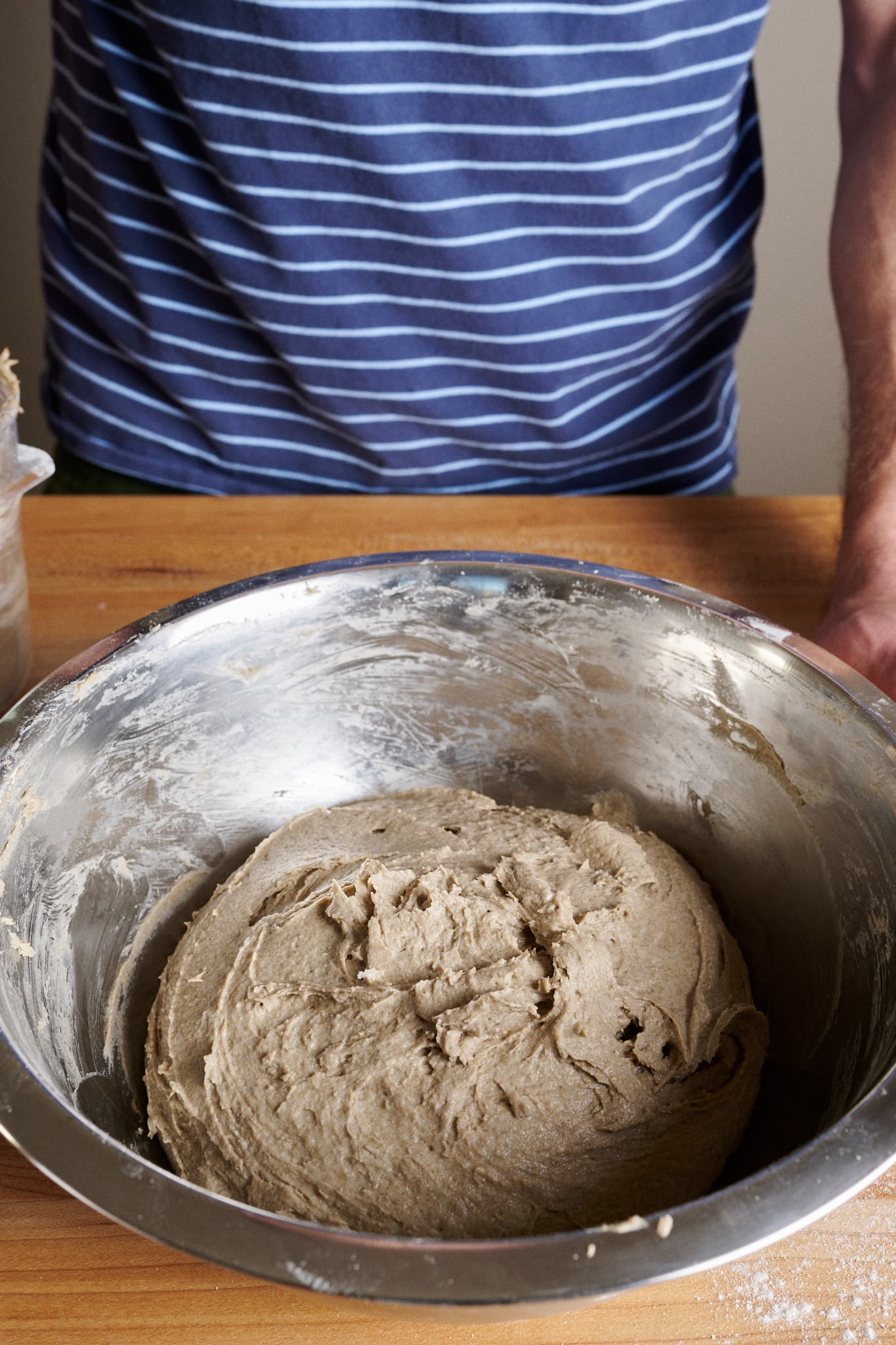

3. Bulk Fermentation – 9:15 a.m. to 9:35 a.m. (20 minutes)
At a heat room temperature, 74-76°F (23-24°C), bulk fermentation ought to take 20 minutes (sure, it’s quick!). As a result of this dough is primarily rye flour, it doesn’t profit from strengthening and subsequently doesn’t require any stretches and folds throughout this time.
4. Form – 9:35 a.m.
Be aware that in case your closing dough temperature was under 82°F (28°C), you would possibly want to increase bulk fermentation. The dough is able to form when it has expanded (about 20%), has smoothed, and feels barely puffy to the contact (see under).
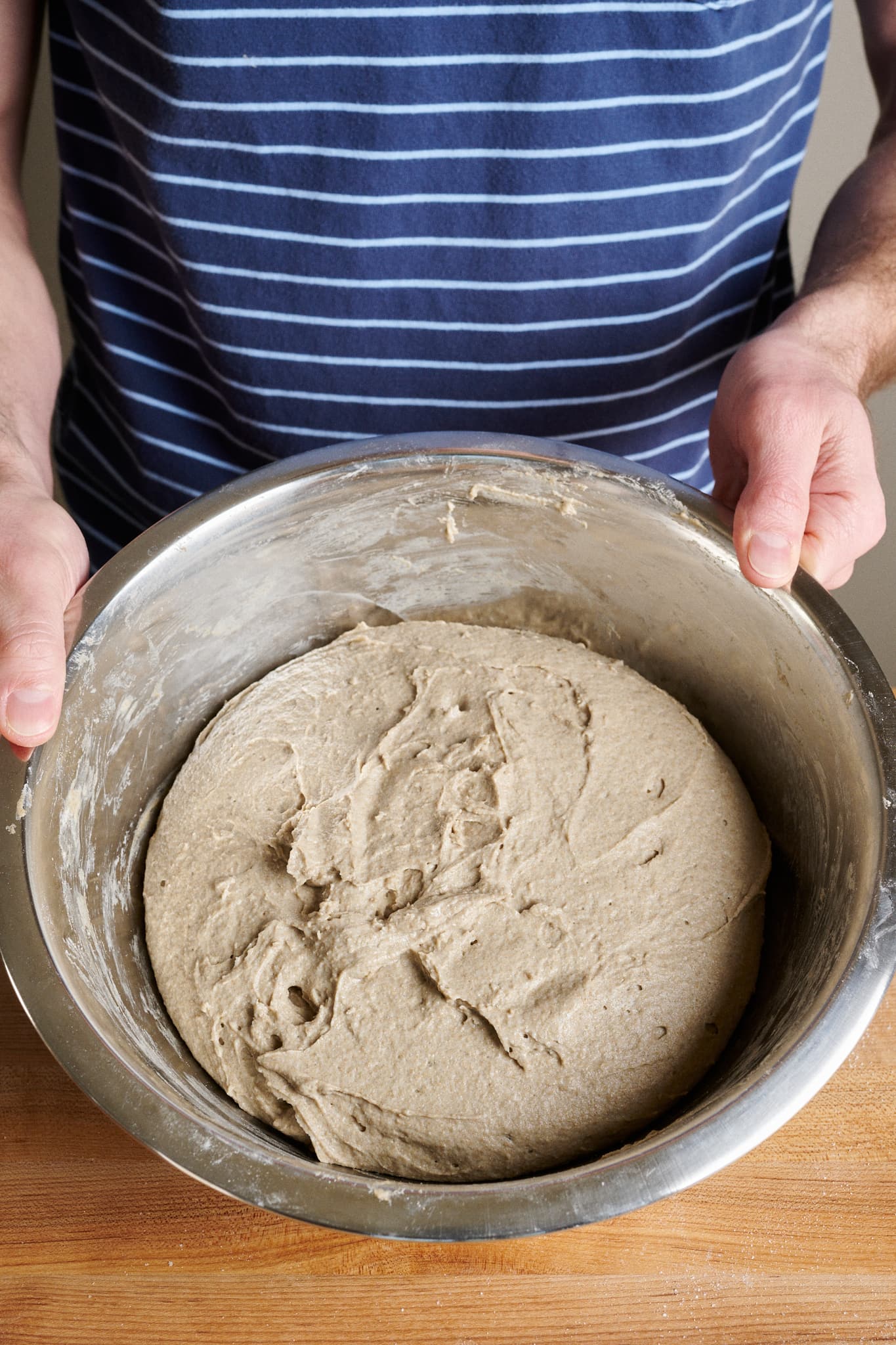

Put together an 8-inch spherical proofing basket or banneton by liberally dusting on complete rye flour. Ensure your complete floor space of the basket’s inside is roofed with flour.
This dough could be very sticky, so it’s vital to make use of sufficient rye flour in your work floor and deal with the dough as little as attainable. The extra you deal with the dough, the quicker it absorbs the dusting flour and turns into sticky.
Flour your work floor, the highest of the dough within the massive bowl, and your fingers. Scrape the dough onto the floured work floor with the floured high of the dough dealing with down.
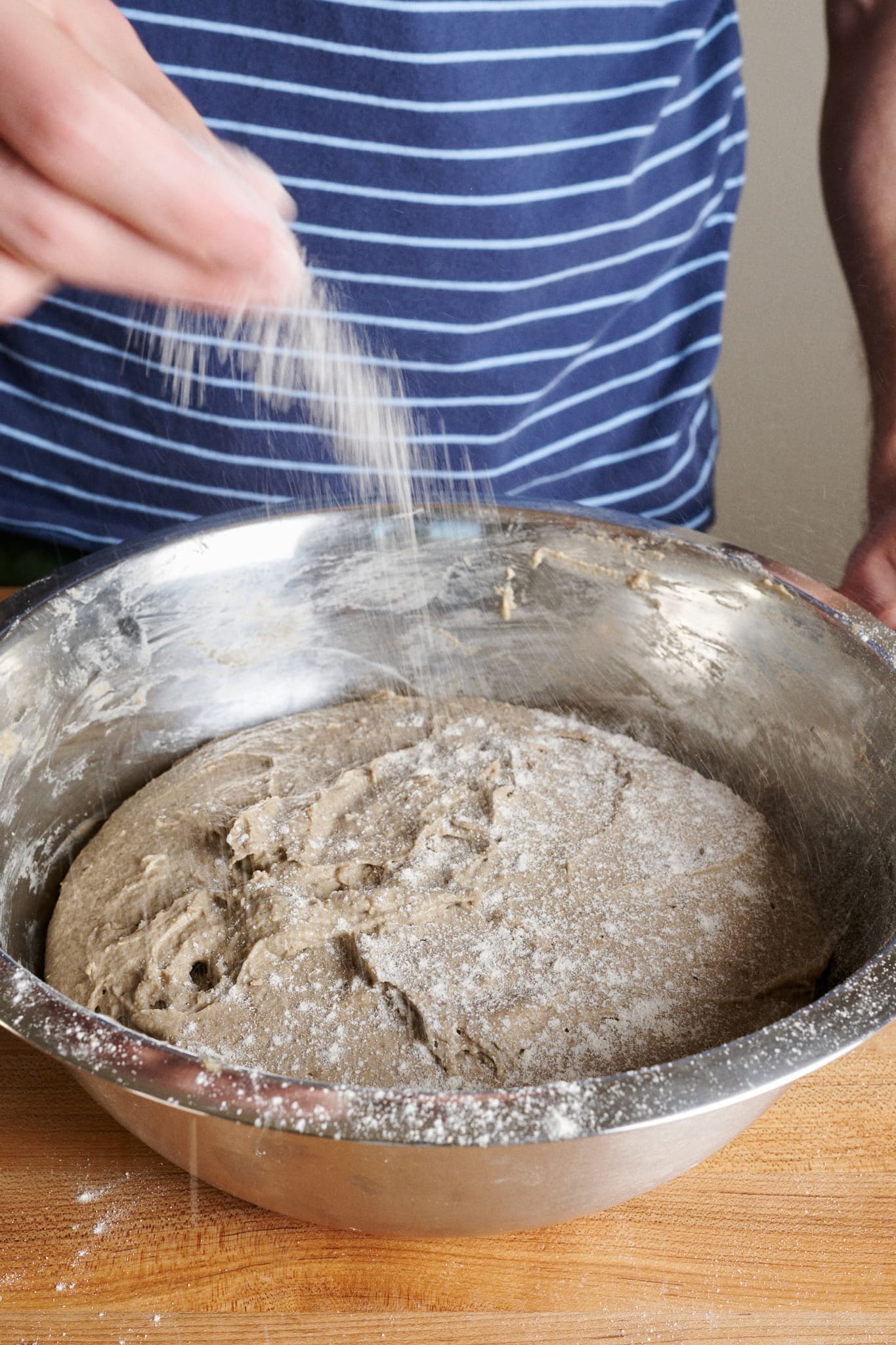

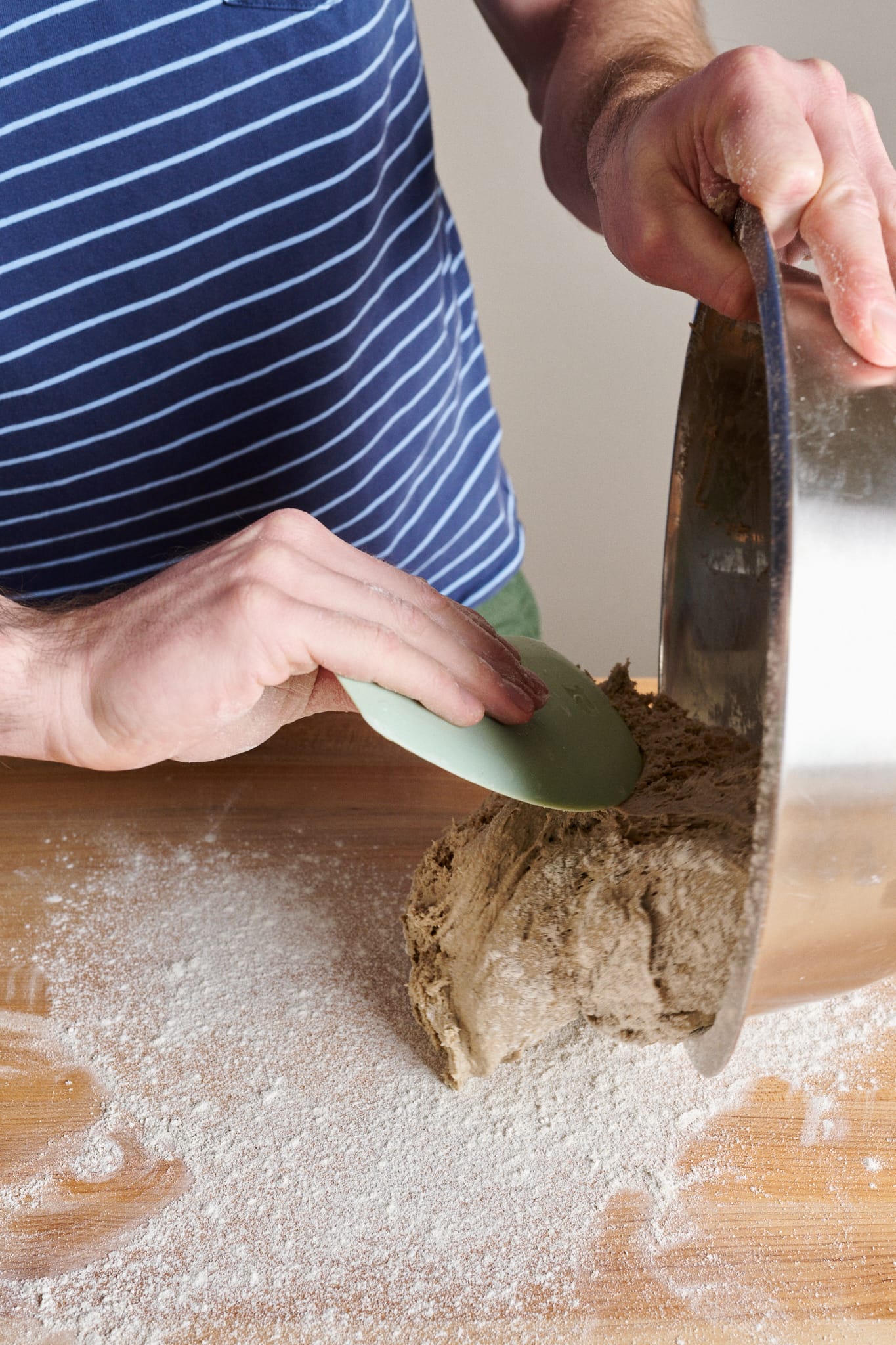

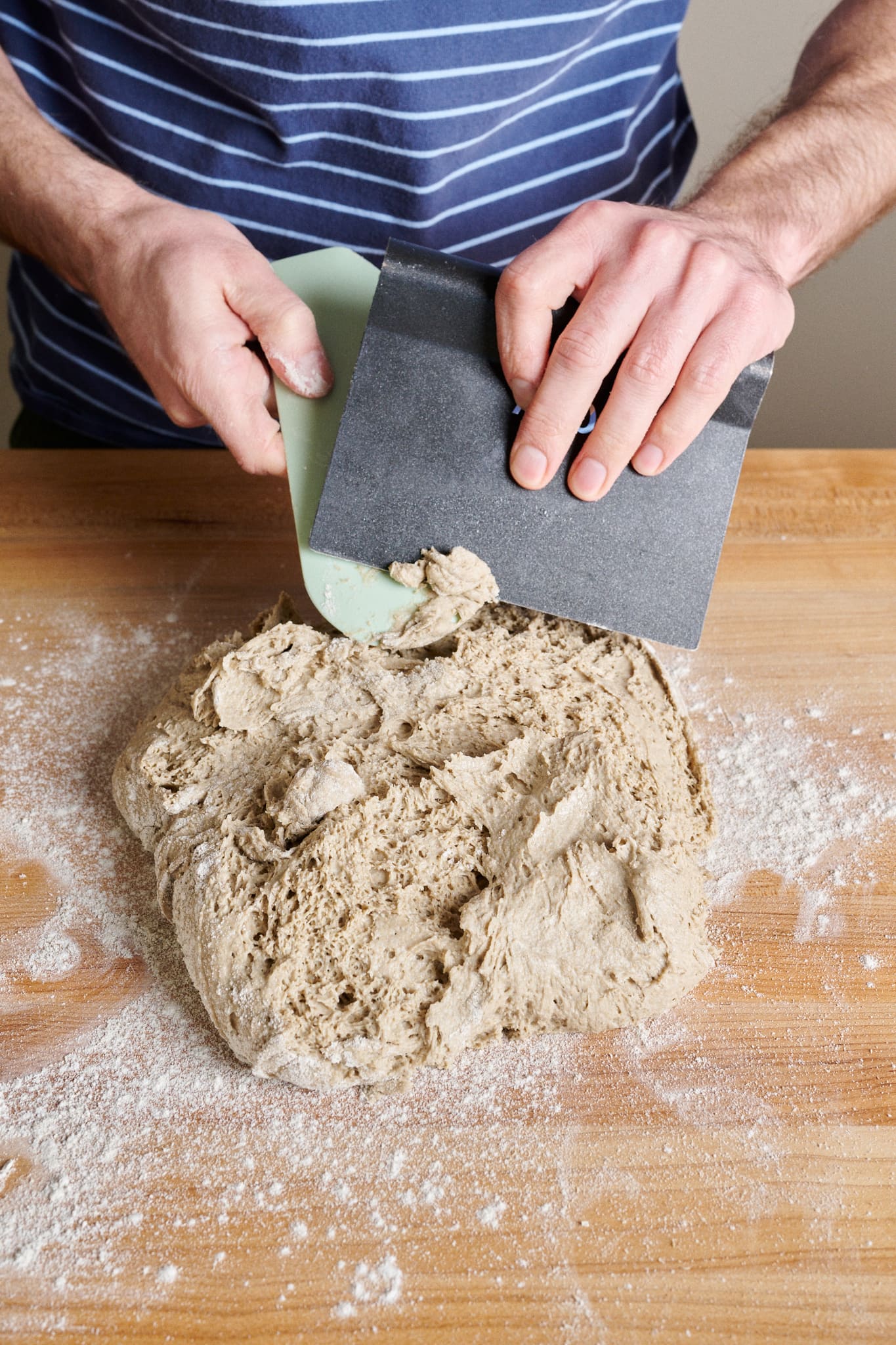

Utilizing your bench scraper, fold the left facet of the dough over to concerning the center. Then, use the scraper to fold the highest (twelve o’clock) all the way down to the center. Repeat for the appropriate facet and backside. It’s best to now have a folded-up form that loosely resembles a sq. in entrance of you.
Utilizing your floured fingers, flip the dough over and rapidly and confidently spherical it till it will get right into a tough ball form. It doesn’t must be an ideal ball. Simply do your finest to collect it with as few motions as attainable.
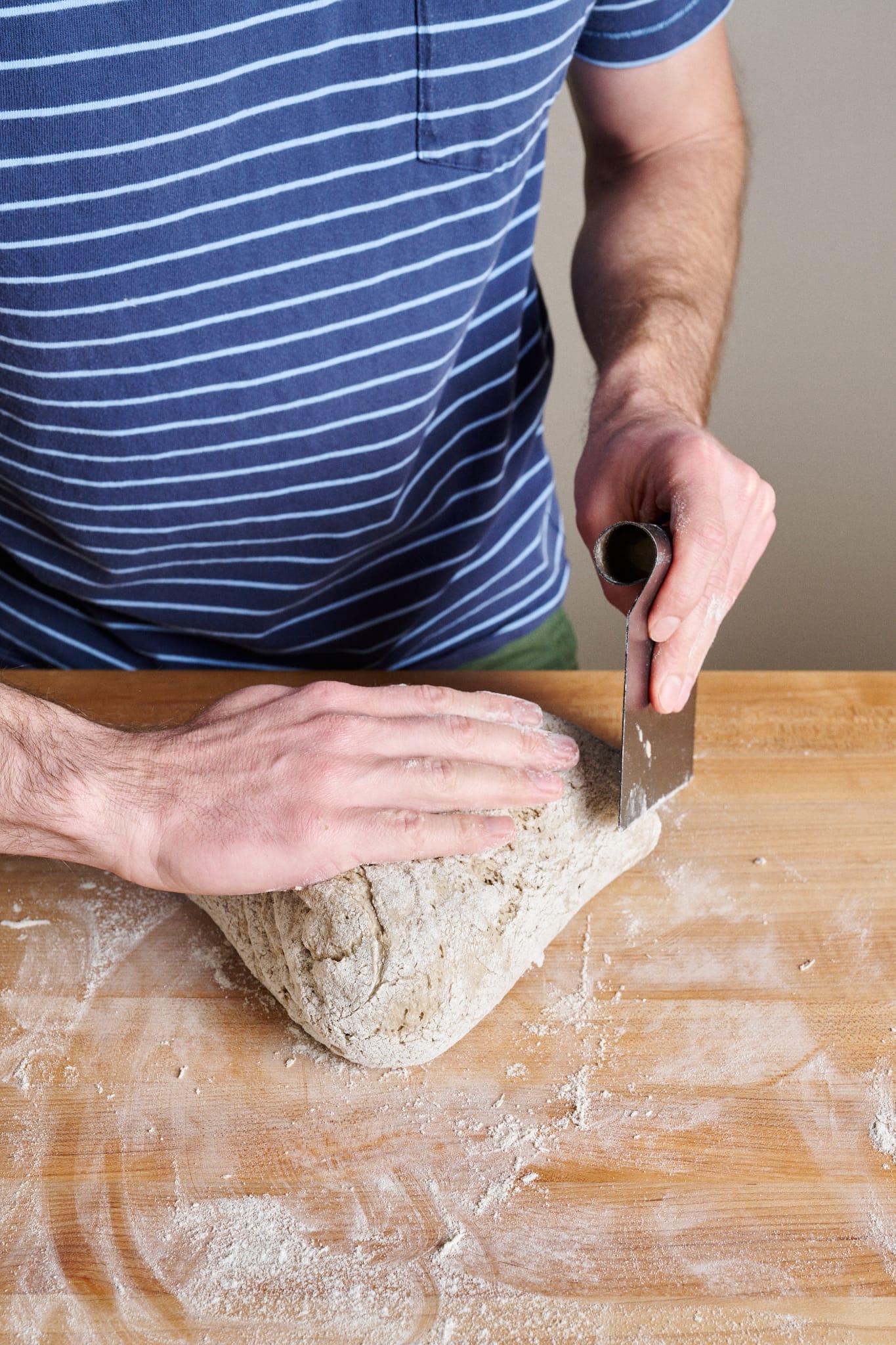

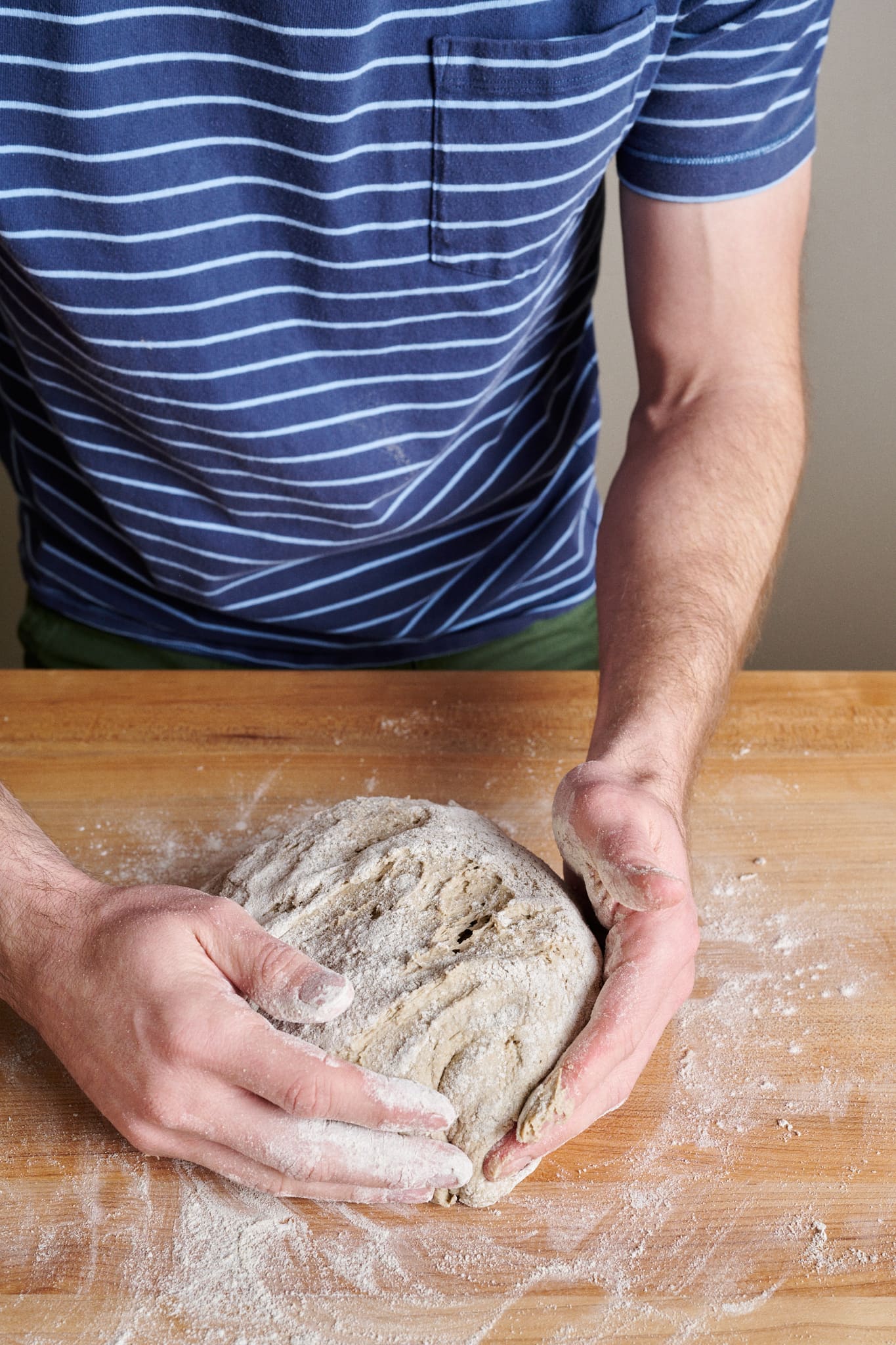

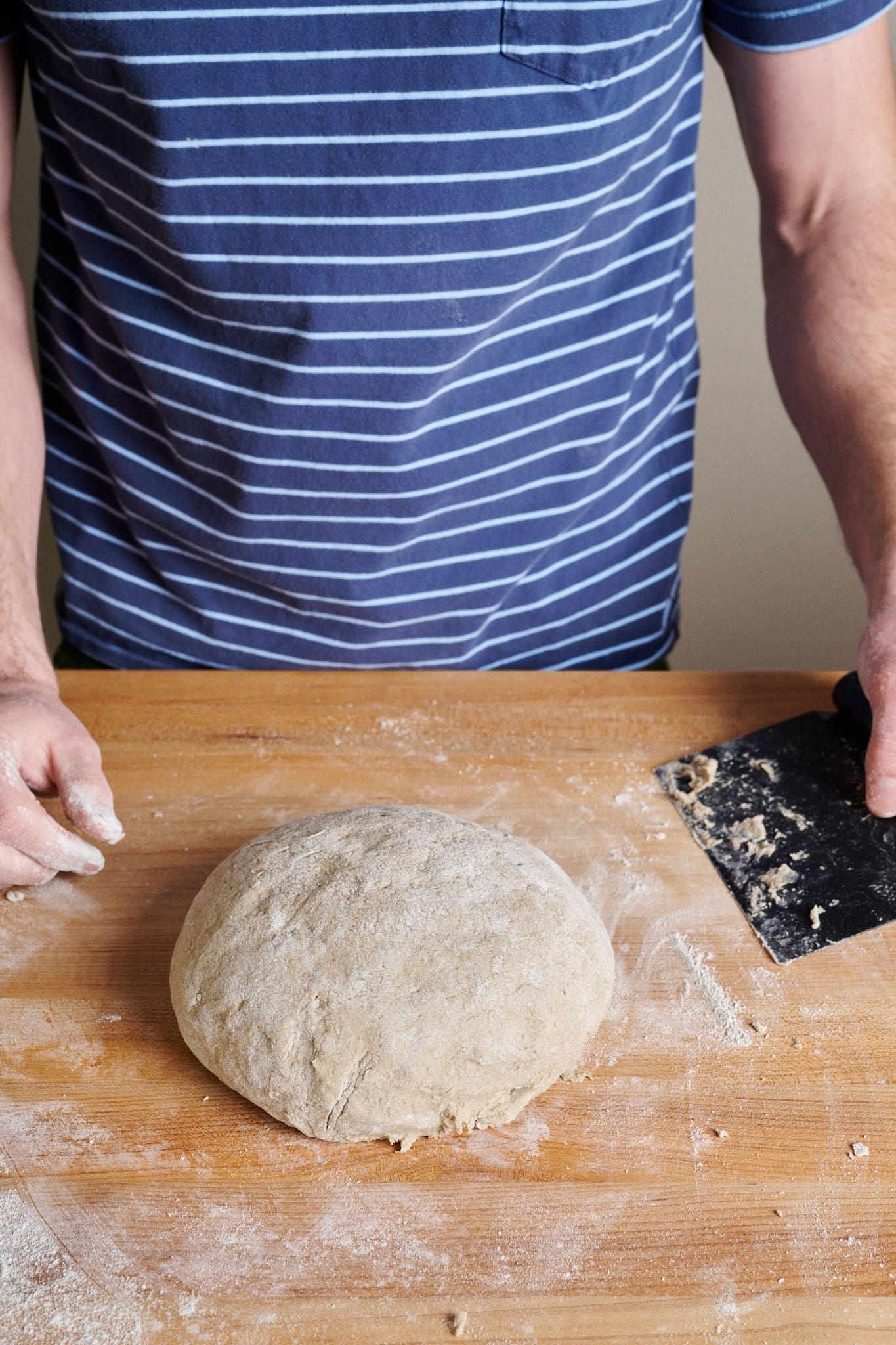

Utilizing your bench scraper, scoop up the dough and place it seam-side-down into the ready proofing basket.
Mud the highest of the dough with extra complete rye flour in a fair layer. This may ultimately crack open because the dough proofs. Cowl the basket with a reusable plastic cowl for an air-tight seal.
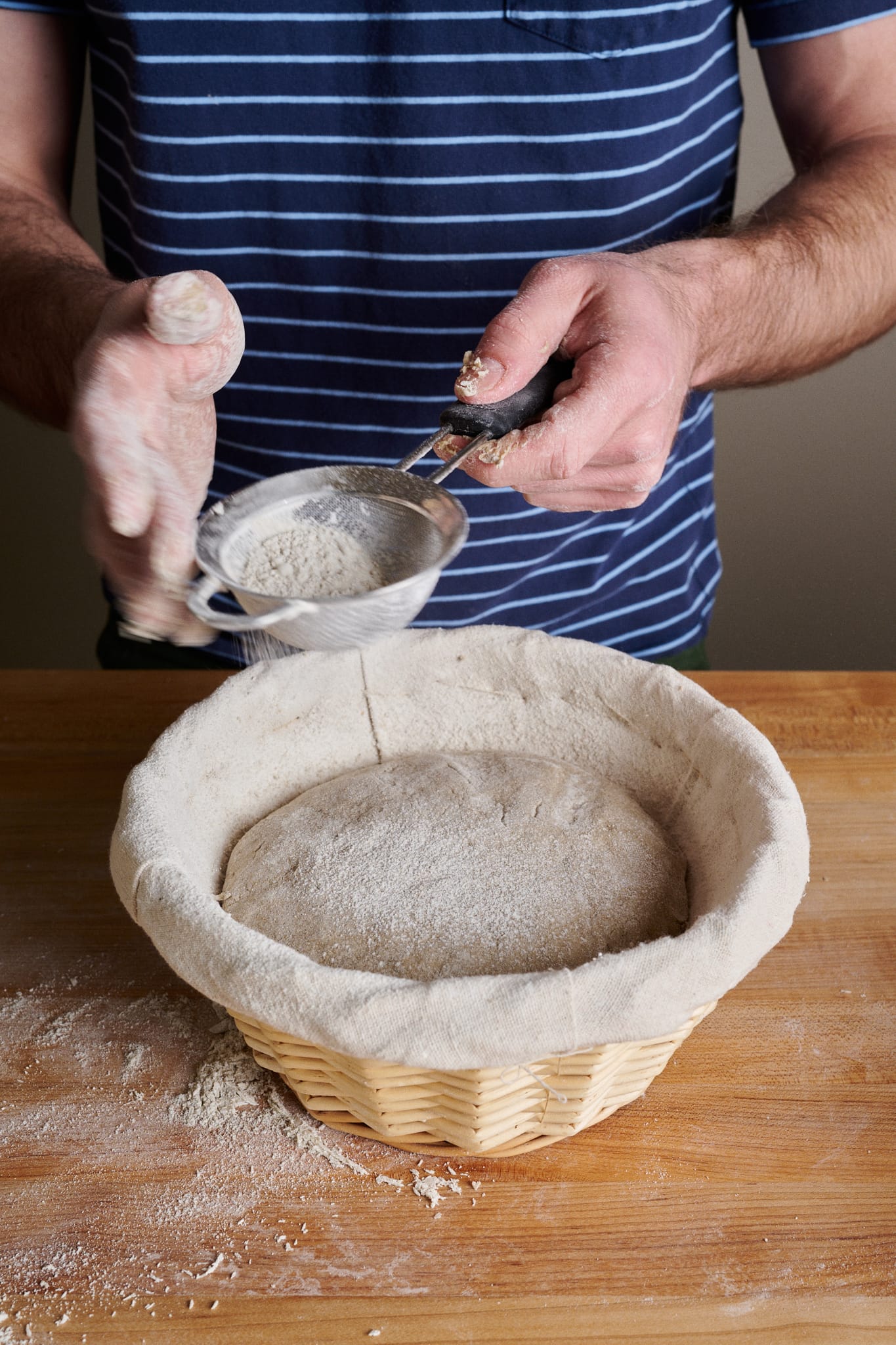

5. Proof – 9:45 a.m. to 10:45 a.m.
At room temperature, this rye sourdough bread will take 1 hour to proof.
Throughout this time, preheat your oven with a baking stone or metal on a rack within the backside third to 450°F (230°C).
6. Bake – 10:45 a.m.
The rye dough is able to bake when it’s puffy to the contact and has cracks which might be a minimum of ½-inch broad all around the high (see under).
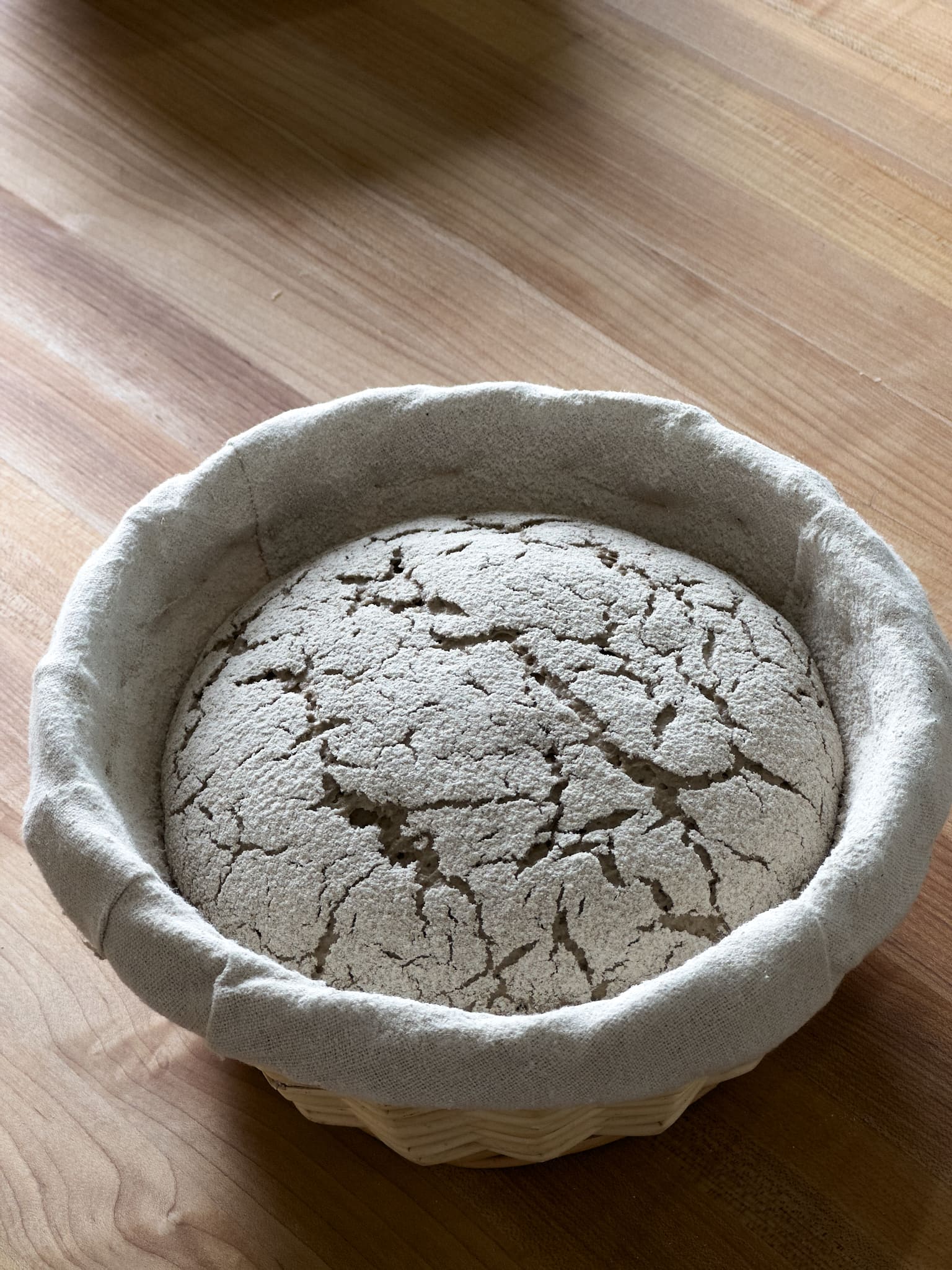

Place a bit of parchment paper on a pizza peel or inverted baking sheet. Tip the dough out of the basket into your hand and rapidly invert it over the parchment paper seam-side down.
Slide the dough onto the preheated baking floor, steam the oven, and bake for half-hour. After this time, scale back the temperature of the oven to 400°F (205°C) and bake for 30 to 35 minutes longer, till the crust is deep golden brown and a knock to the underside sounds a bit hole.
Let the bread cool on a wire rack for half-hour. Then, to make sure the inside is totally set, place it inside a plastic bag or cowl it with baker’s linen and let it relaxation for twenty-four hours earlier than slicing.
Description
This freeform rye is made with 90% whole-grain rye flour for an intensely fragrant and flavorful loaf of bread. Good for open-faced sandwiches or topped with good salted butter, it’s going to be an instantaneous favourite and a brand new staple in your baking quiver.
Levain
- 272g complete rye flour
- 272g water
- 41g ripe sourdough starter (100% hydration)
Foremost Dough
- 272g complete rye flour
- 60g high-protein white bread flour
- 272g water
- 11g effective sea salt
- All of the levain
- Put together the levain – 9:00 p.m.
Combine the Levain elements in a big jar or medium bowl and go away them coated with a lid or reusable plastic bowl cowl at a heat temperature, 74-76°F (23-24°C), to ripen in a single day. - Combine – 9:00 a.m. (the following day)
Heat the blending water to 82°F (28°C). Place the flour, water, salt, and levain in a big bowl. With moist fingers (or, my choice, utilizing a sturdy dough whisk), combine totally till no dry bits stay. Collect up the dough right into a ball within the heart of the blending bowl (see under, proper). - Bulk fermentation – 9:15 a.m. to 9:35 a.m.
At a heat room temperature, 74-76°F (23-24°C), bulk fermentation ought to take 20 minutes (sure, it’s quick!). No stretches and folds are vital. - Form – 9:35 a.m.
Put together an 8-inch spherical proofing basket or banneton by liberally dusting on complete rye flour. Ensure your complete floor space of the basket’s inside is roofed with flour. Flour your work floor, the highest of the dough within the massive bowl, and your fingers. Scrape the dough onto the floured work floor with the floured high of the dough dealing with down. Utilizing your bench scraper, fold the left facet of the dough over to concerning the center. Then, use the scraper to fold the highest (twelve o’clock) all the way down to the center. Repeat for the appropriate facet and backside. It’s best to now have a folded-up form that loosely resembles a sq. in entrance of you. Utilizing your floured fingers, flip the dough over and rapidly and confidently spherical it till it will get right into a tough ball form. Utilizing your bench scraper, scoop up the dough and place it seam-side-down into the ready proofing basket. Mud the highest of the dough with extra complete rye flour in a fair layer. Cowl the basket with a reusable plastic cowl for an air-tight seal. - Proof – 9:45 a.m. to 10:45 a.m.
At room temperature, this rye sourdough bread will take 1 hour to proof. Throughout this time, preheat your oven with a baking stone or metal on a rack within the backside third to 450°F (230°C). - Bake – 10:45 a.m.
Place a bit of parchment paper on a pizza peel or inverted baking sheet. Tip the dough out of the basket into your hand and rapidly invert it over the parchment paper seam-side down. Slide the dough onto the preheated baking floor, steam the oven, and bake for half-hour. After this time, scale back the temperature of the oven to 400°F (205°C) and bake for 30 to 35 minutes longer, till the crust is deep golden brown and a knock to the underside sounds a bit hole. Let the bread cool on a wire rack for half-hour. Then, to make sure the inside is totally set, place it inside a plastic bag or cowl it with baker’s linen and let it relaxation for twenty-four hours earlier than slicing.
Notes
You should definitely let the loaf cool a minimum of in a single day earlier than reducing to make sure the inside is not gummy.
Hydration Be aware: As with all bread recipe, you would possibly want to regulate the dough’s hydration to fit your flour (particularly if baking in a moist atmosphere. When mixing, maintain again a little bit of the water and add it provided that the dough appears like it will possibly deal with it (take a look at the pictures under to assist choose the consistency).
Key phrases: Rye, brod, wheat, sourdough
Sourdough Rye Bread FAQs
Why did the highest crust of my rye bread separate from the inside?
The highest crust, also called the “flying crust,” can separate if the levain (preferment) isn’t totally ripe when it’s blended into the dough. Ensure the levain has a full 12 hours at a heat temperature to ripen, erring on the facet of overly ripe than underneath. One other reason behind the flying crust is dough that’s overhydrated. The dough ought to really feel smooth, moist, and sticky however not soupy or unfastened (extra like hummus than pancake batter).
Can I exploit pumpernickel flour for this rye bread recipe?
My choice for this recipe is finely milled complete darkish rye flour, however complete grain pumpernickel, which is normally milled a little bit extra coarsely, may also work nicely. If utilizing pumpernickel flour, contemplate growing the hydration of the recipe by 2 to five%.
Why is the inside of my rye bread gummy?
If rye bread is minimize too early earlier than it has had an opportunity to set totally, usually 24 hours or extra, the inside could be gummy and persist with, or streak, the perimeters of your knife when slicing.
Is rye gluten-free?
No, rye isn’t gluten-free. Whereas it doesn’t have the identical gluten content material and traits of wheat flour, leading to tall loaves of bread, it nonetheless comprises gluten.
What’s Subsequent?
For a rye pan loaf supposed for Danish-style open-faced sandwiches, see my Rye Sourdough and Smørrebrød recipe.
Or, when you’re on the lookout for a big freeform loaf with only a contact of rye, my Spelt, Rye, and Entire Wheat Sourdough Bread is loaded with taste however gentle and ethereal.
Thanks to Michael Shulze (Brotbruder) on your assist with this recipe!
